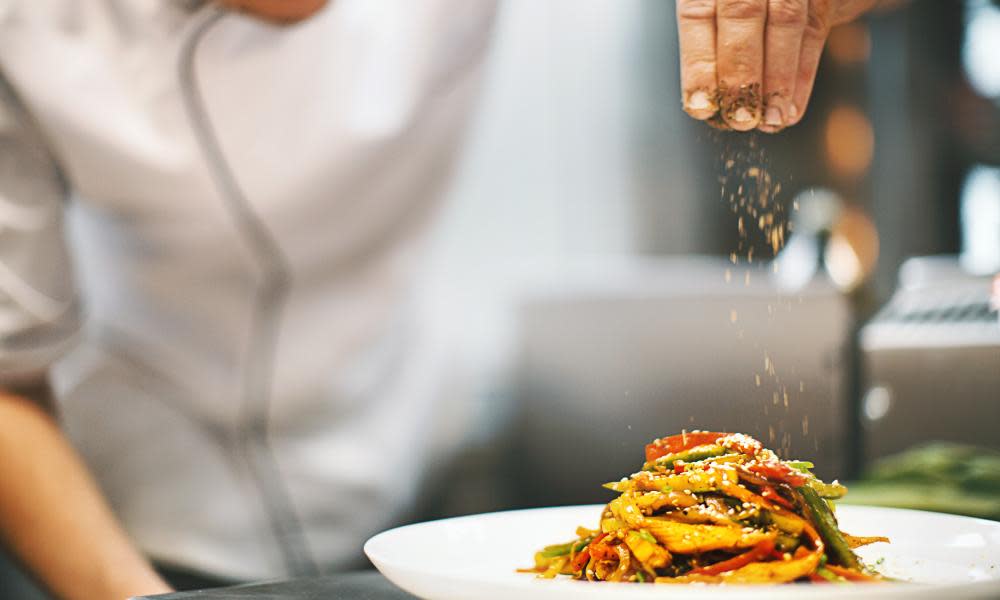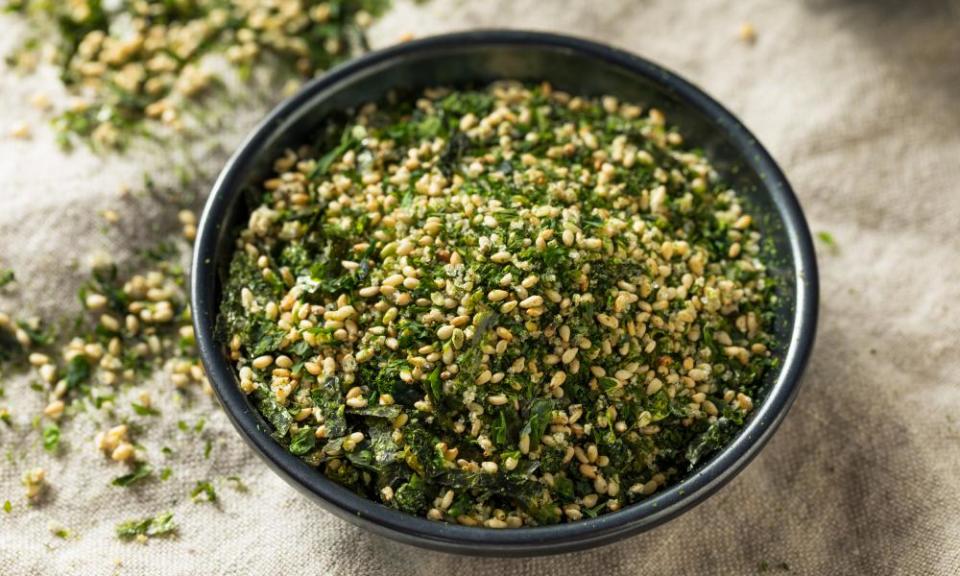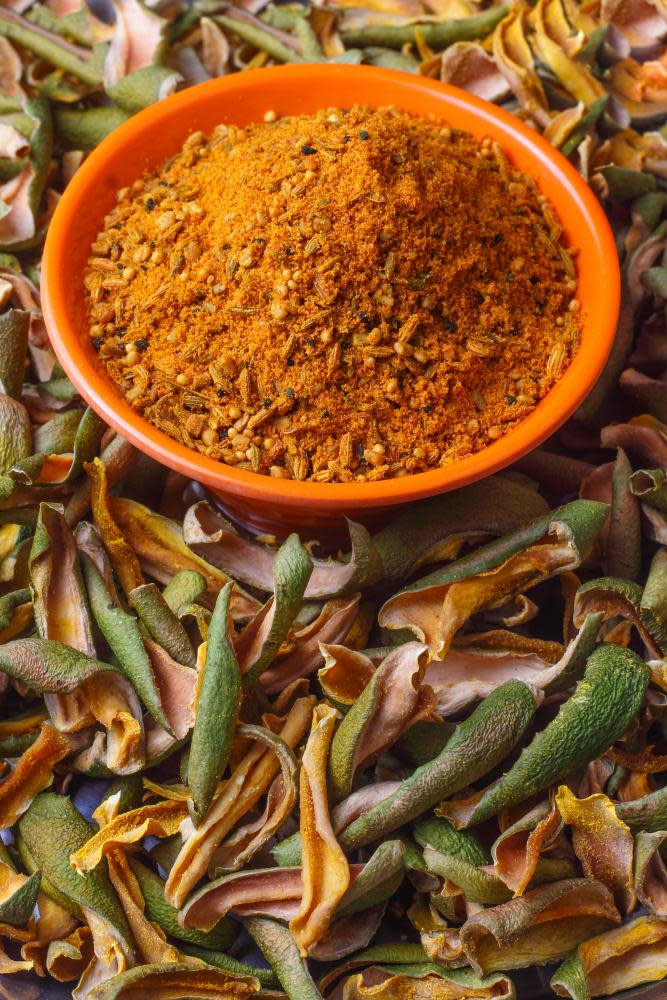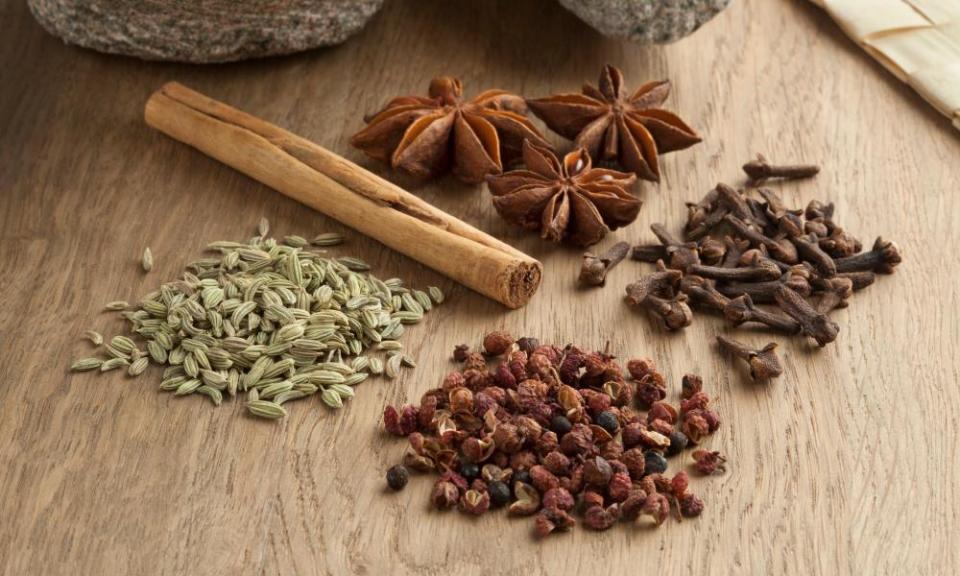Spice up your life! 22 sensational seasonings that aren’t salt or pepper

Historically, Britain has been timid about seasoning. Salt and pepper are the standard duo in the UK, while an exhilarating array of flavourings is deployed globally to tweak cooked foods: traditional spices, evolving spice mixes, clever powders created by imaginative chefs. In deep midwinter, what could be better than sprinkling a dash of vibrant colour across your meals? Here are 22 ways to spice up your food in 2022.
Dehydrated chicken skin
“It will transform chips, fish, boring salads, anything,” enthuses Sam Grainger, the chef-owner at Belzan in Liverpool. On a greaseproof tray, flatten chicken skin, salt it and scatter with garlic and thyme. Place baking paper on top and a tray to weigh it down. Oven roast at 170C (150C fan)/335F/gas 3½ for 40 minutes, until the skin is crisp. Remove the top tray and paper, and continue to dry the skin in the oven at about 75C fan for a further eight hours. Let it cool on kitchen towels to absorb any oil. Pat dry.
Using a blender, blitz the skin and a little coarse salt to a fine powder. Portion out your batch of powder – you could use an ice-cube tray or clingfilm “twists” – and freeze in an airtight container.
Sumac
“On Iranian tables, you’ll find salt, pepper and a shaker of lemony sumac to add floral acidity to dishes,” says Marwa Alkhalaf, the chef at Nutshell in London. Alkhalaf namechecks the sumac – a powder ground from the dried fruit of the sumac shrub – from Anjoman and Persia Food. “I like its sweet-sour flavour on ice-cream and fruit.”
Furikake

“It’s very popular in Japan,” says Masaki Sugisaki, the chef-owner at Dinings SW3 in London. Furikake is normally used to transform steamed rice, but this crunchy, umami blend of sesame seeds and seaweed, seasoned with slow-roasted fish or egg, is a potential pick-me-up for drab salads or tuna-topped baked potatoes, too. Sugisaki rates the Noritama brand.
Dukkah
This Egyptian creation pivots around nutty flavours (sesame, almond, hazelnut, pumpkin, chickpea), toasted with herbs and spices (mint, cumin, coriander), which are pounded into a powder or a crunchier, chunky consistency. “Every family has their ratios and spice preferences,” says Mitshel Ibrahim, the chef-owner at Ombra in London.
Dukkah was traditionally used as hummus dressing or to top dipping oils for breads and meze vegetables. But its “fragrant, gentle spice” is a versatile addition to breakfast eggs, soups, couscous and fried fish. Ibrahim recommends the stockist Persepolis, “a little shop of Middle Eastern wonders” in Peckham, south-east London, that ships nationwide. The tagline for its dukkah is: “So good you’ll want it on everything.”
Gremolata
This chiffonade of finely chopped garlic, lemon zest and flat-leaf parsley brings a fresh, savoury sheen to a number of dishes, says Esther Miglio, a co-owner of OWT in Leeds: “It works brilliantly on stews, fried chicken, roast vegetables, through salads.” Adjust ratios to taste, but two-thirds garlic cloves to one-third fresh parsley and the zest of one lemon will make gremolata for four to six people. Refrigerate for up to three days.
Achar masala

Primarily a pickling mix, this crunchy combo of salt, chilli, asafoetida, mustard and fenugreek seeds, bound with a little oil, doubles as a dry Gujarati condiment. “It’s used on rice and dal,” says Mayur Patel, a co-owner of the Bundobust restaurants in northern England. “When I was a kid, my mum would smash up Seabrook’s ready salted crisps – their crinkles hold the masala better – and sprinkle achar and lemon juice into the packet. We’d have that on white-bread sandwiches.”
In south India, “gunpowder”, or milagai podi, is considered similarly useful. A seasoned mix of roasted, ground coconut and lentils, it is best known for flavouring potatoes, but Avinash Shashidhara, the head chef at Pahli Hill in London says: “We use it on everything, even on ghee-buttered toast.”
Powdered seaweed
A fantastic salt alternative, saysGrainger: “It gives another layer, umami and flavour impact, without tasting like pure salt.” In a blender, with a little salt to help the grind, blitz sheets of seaweed (“nori or dulse work best”) into fine dust. “It’s great on fish or vegetable dishes.”
Dunn’s River all-purpose seasoning
From the US seafood seasoning Old Bay (a favourite of Ravinder Bhogal, the chef-owner at Jikoni in London) to lapsang souchong salt, there are numerous ways to titivate chips. A moreish mix of paprika, mustard and onion powder (among other spices), Dunn’s River’s all-purpose seasoning is recommended by Michelle Miah, a co-owner of the London restaurant Rudie’s Jerk Shack: “Some seasonings can be salty or overly flavoursome. Dunn’s has balance.”
Phrik pon
Roast, ground chillies complete khruang phrung, a quartet of Thai table condiments (including sugar, fish sauce and vinegar-pickled chillies) that enable endless customisation. Andrew Chongsathien, the owner of Brother Thai in Cardiff, uses phrik pon’s “exciting” smoky spice instead of orthodox chilli flakes.
In a wok, roast long red dried chillies (shorter ones will be hotter) on a medium-high heat for three minutes, ensuring they do not blacken (open a window first). “When you start coughing, they’re done,” says Chongsathien. “When cool, grind the chillies in a pestle and mortar. I prefer coarse flakes.” In an airtight container, “they keep for ever”.
Shichimi tōgarashi
With its chilli heat, citrus peel, sansho pepper and roasted sesame savouriness, this aromatic, seven-ingredient topping is essential in Japan. “In good versions, you taste all the flavours in one,” says Kaori Simpson, the chef-owner at Harajuku Kitchen in Edinburgh. Use tōgarashi on noodles, soups, tempura and fried chicken, but not ramen: “It’s a no-no on Japanese versions of Chinese foods; instead, you have white pepper and chilli oil.”
Espelette

“Black pepper is too aggressive,” says Josh Overington, the chef at Le Cochon Aveugle in York. He uses the “bittersweet, elegant heat” of this Basque chilli pepper. Traditionally used to cure jamón, espelette is great on eggs, asparagus, grilled chicken and bland foods, where its subtlety can shine.
Gochugaru
This sun-dried, ground Korean chilli, which gives kimchi its red colour, comes in a variety of consistencies and heats, but its “bright, fruity, slightly smoky flavour” makes it a versatile ingredient and table condiment, says Judy Joo, the chef-owner of the Seoul Bird restaurants in London. “I sprinkle it on everything from pizza to veggies,” says Joo. “Store it in your freezer to keep it zesty.”
Cumin
Used to season everything from boiled eggs to roast lamb, ground cumin and salt are the staple Moroccan table condiments, says Nargisse Benkabbou, a chef and the author of the cookbook Casablanca. Cayenne pepper is also offered – “to add heat without too much flavour”.
Paprika
“Agridulce [a Spanish sweet-and-hot paprika mix] is used on every fried egg of ours,” says Ben Wright, the owner of Porta in Chester. It also gives a smoky kick to fried potatoes or octopus.
Paprika is big in Romanian cooking, too. Irina Georgescu, the author of the cookbook Carpathia, uses the smoked version alongside salt and pepper: “Sprinkle on potato salads, omelettes, fried fish and roast vegetables, especially carrots or parsnips, where spice – not salt – complements their flavour.”
Chinese five-spice salt

“I’m a big fan of Cantonese-Vietnamese ‘spicy salt’ – classic five-spice with salt – used as a dip for fried and grilled poultry,” says Lap-Fai Lee, a Birmingham-based restaurant consultant and food tutor. “A good cook will make this fresh, doing enough for that meal.” In a hot pan, toast salt for 30 seconds with whole Sichuan peppercorns, cinnamon or cassia, star anise, cloves and fennel seeds. The ratio is 2:1 salt to five-spice (the spices combined in equal amounts). For extra oomph, add MSG powder in equal quantity to one of the spices. “It’s not the same without it,” says Lee. Grind the mix into a fine salt and dip your meat delicately as you eat.
Sal de gusano
A Mexican salt made by roasting so-called “worms” (caterpillar larvae) found on the agave plant, then mixing them with salt and sometimes chillies. “I add it where I want smoky depth,” says Shaun Hurrell, the chef-owner at Barrio Comida in Durham. That might be sweetcorn, a steak or popcorn. Sal de gusano is available from Cool Chile Co.
Burnt onion powder
“A versatile workhorse,” says Alex Rushmer, the chef at Vanderlyle, a plant-focused restaurant in Cambridge. Peel red or white onions, separate the “petals” on a roasting tray and bake them in a process of “dehydration, caramelisation and controlled burning” at 160-190C (140C-170C fan)/325-375F/gas 3-5 for approximately one hour, until dried and dark brown. Keep an eye on their progress: “They should turn to powder when you squeeze them in your hand.”
Blitz to a fine powder in a blender, store in a dark, airtight container for two weeks, then “sprinkle on anything you want to taste oniony. It’s an awesome seasoning for roasted nuts and would be great over white pizza, or sprinkled on a cheese crouton on french onion soup.”
Za’atar
This fusion of sumac, dried thyme, toasted sesame and salt (“characteristically bright and fresh, earthy and zesty,” says Calvin von Niebel, the executive chef at the Ottolenghi restaurants in London) is terrific when used to finish seafood, dusted over labneh or on pitta pieces or chips.
Tajín

This zingy combo of chillies, salt and dehydrated lime (it is hard to find here but available online) is ubiquitous in Mexico. “It’s found in fine restaurants, at home on popcorn, on street stalls mixed with fruit or veggies. I love it on a grated carrot, beetroot and jicama yam slaw,” says Adriana Cavita, who will launch her eponymous London restaurant in spring.
Related: ‘This sauce will change your life!’ 30 brilliant condiments to transform your tired lockdown dishes
Yaji
Commonly retailed as “suya spice”, after the west African grilled meat skewers it regularly dresses, yaji comes in several varieties. It has core ingredients – chilli and onion powders, ginger, paprika and cloves – but there have been additions as its fame has spread from northern Nigeria. Garlic, explains Adejoké Bakare, the chef-owner at Chishuru in London, “was not common in the old days”.
There is a specific yaji for cooking sauces (this includes dawadawa, fermented locust bean), while peanut-boosted yaji-kuli is used on those suya kebabs, hot off the grill. “It adds texture to the meat,” says Bakare, who grew up using basic yaji to season salads or, in combination with mai shanu butter, rice pancakes and couscous.
Nut parmesan
“A super-savoury seasoning with a cheesy nutritional-yeast flavour, and I add chilli for a kick,” says Bettina Campolucci Bordi, the author of the vegan cookbook Happy Food. To make a 75g sample, blitz 30g each of hazelnuts and almond flour with half a teaspoon each of salt and nutritional yeast, adding chilli flakes to taste. Refrigerate in an airtight container for up to two weeks. “I keep it handy to season soups, pastas and roast veg, or as a toast-topping.”
Chaat masala
This tangy, spice mix (key ingredients: dried mango and black salt) is, of course, used in the potato, chickpea and gram-salad-cum-snack chaat, but it also seasons “everything fried”, says Gouranga Bera, the chef at Curry Leaf Café in Brighton. “Add chaat to pakoras and bhajis when they’re crisp, so the spices stick. Its sweet, sour, spicy taste is also delicious on grilled meats with lime or lemon juice.”
Chaat masala’s addition of a “savoury note” to fruit salads has been a “revelation” for Curry Leaf’s co-owner Euan Sey, who suggests trying MDH’s chunky chaat masala as a premixed version: “I’m something of a fruit dodger, but I love fruit chaat.”

 Yahoo News
Yahoo News 
